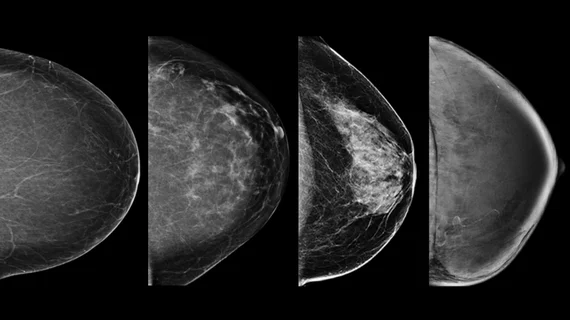What breast density status can tell us about cardiovascular risk
Breast density is most often discussed within the context of breast cancer risk, but new research suggests that it also could be used as a marker of cardiometabolic health.
In a new paper in Clinical Imaging, experts detail associations between breast density category and epicardial adipose tissue volume (EATv), which is known to be related to coronary artery disease (CAD). Specifically, the team found significant associations between low breast density, increased EATv and the presence of CAD.
Experts involved in the research suggest that their findings could pave the way for improved cardiovascular disease risk assessments for women, as current protocols still leave many behind.
“Women with a high risk for CVD are less likely to receive early intervention and preventative treatment compared to men,” Nitesh Nerlekar, with the Victorian Heart Hospital in Australia, and colleagues note. “Improvements in CVD outcomes in women have slowed compared to those seen in men over the past three decades. Current population-based cardiovascular risk calculators have been shown to underestimate risk of CAD in women.”
EATv is well quantified on coronary computed tomography angiograms (CCTA). However, unlike mammograms, women do not routinely undergo CCTA exams.
“There is significant appeal in the use of breast density assessment, as it can be evaluated on already performed mammography without additional radiation exposure,” the group writes.
Building off of known similarities between EATv and breast adipose tissue's pro-inflammatory tissue deposits, researchers sought to determine if EATv derived from routine mammograms could be used to flag women at greater risk of CAD. To do this, they retrospectively examined the cases of 153 women who had undergone both clinically indicated CCTA and mammography screening. A semi-automated software was used to quantify EATv on imaging, and those results were compared to patients’ BI-RADS category and the presence, absence and severity of coronary artery plaque.
The majority (nearly 70%) of patients had low breast density, or high tissue adiposity. Women with low breast density were typically older, had higher BMI and higher rates of hypertension.
These women also showed greater EATv, regardless of their age or history of hypertension. Low density was closely linked with CAD, independent of EATv and modifiable or non-modifiable cardiometabolic risk factors, indicating that the association between low density and CAD extends beyond EATv. Less dense tissue was found to be more common among women with mild (76.5 %), moderate (73.9 %) and severe (80%) CAD, the group notes.
“Although minimally studied in the context of CAD, breast adipose tissue has also shown potential for adipokine production, primarily in adipocytes that sit around the margins of tumors in breast cancer," the authors explain. "Furthermore, a study by Llanos et al. examining women with no breast cancer history found that although there was a significant correlation between the plasma to breast adipokine ratio of the adipokine leptin, this was attenuated in patients categorized as overweight or obese based on BMI.”
The group adds that it is possible that breast adipose tissue could play a role in inflammatory fat activity, similar to the way visceral fat deposits—another cardiovascular risk factor—in other areas do.
“As visceral fat is a significant cardiovascular risk marker, the ability to identify incidentally increased breast adipose tissue may act as a surrogate for other dysfunctional visceral fat depots,” the authors explain. “Should breast adipose tissue be found to have a similar pro-inflammatory, pro-atherogenic profile to visceral adipose tissue, there may be a role for application of this knowledge through mammography programs that are already implemented worldwide for breast cancer screening.”
Learn more about the research here.

